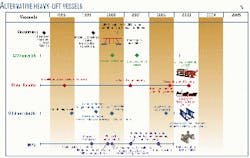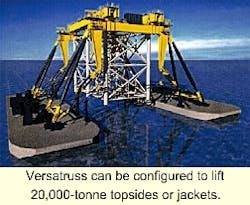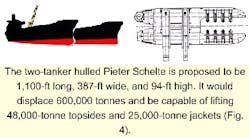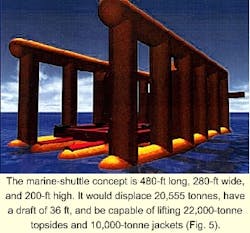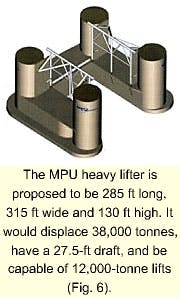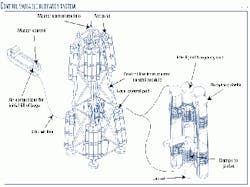Alternative heavy lift vessels, in various stages of completions, may help in the removal of large platforms.
Twachtman Snyder & Byrd Inc. (TSB), Houston, compiled Fig. 1 showing a timetable for new vessel availability. The figure is part of TSB's November 2000 study, "State of the Art of Removing Large Platforms Located in Deep Water," prepared for the US Minerals Management Service.
The study's conclusion says that these designs may someday prove to be safer, more cost-effective for both topsides and jacket, although removal of deepwater jackets remains problematic.
The new heavy-lift technologies include the Versatruss scheme, GM heavy lift, Pieter Schelte, offshore shuttle, and MPU heavy lifter. Also such technology as John Gibson strand jacks and buoyancy devices may facilitate abandonment.
Versatruss
The TSB study describes the Versatruss Americas LLC, Belle Chasse, La., system as a balanced, symmetrical, underside lift concept that uses a truss formation to lift a heavy load. The concept employs three readily available components: standard cargo barges as lifting platforms, steel A-frames for structural support, and hydraulic winches to supply the lifting force.
Fig. 2 shows the system configurations for lifting a topsides and jacket.
The study says that the system can be designed to accommodate the largest topsides currently in existence. Once lifted, topsides can be towed to shore or other locations, or lowered onto a cargo barge.
The Versatruss system has been used to remove and install several topsides. Its largest lifts, according to the study, included an August 1997 removal of a 1,225-ton deck from Amoco Corp.'s Eugene Island 367 and a September 2000 installation of a 5,330-tonne topsides for Chevron Corp. in Lake Maracaibo, Venezuela.
The study says the system has no theoretical load capacity limit, although the system is not well suited for removing jackets because the kinematics make it difficult to lift a jacket from the water, although partial jacket removal is possible.
GM heavy lift
ProSafe ASA, Tananger, Norway, and Global Maritime Heavy Industries 's (GMHL) heavy-lift concept uses an existing semisubmersible with a U-shaped extension (Fig. 3). The vessel displacement is 40,100 tonnes, and it is not self-powered, relying on tugboats for movement. The vessel's designed lift capacity is 12,000 tonnes.
According to the TSB study, platform decommissioning with the vessel involves deballasting to lower an extension below the bottom of the topsides. After it is in position, the vessel is raised to a point where the topsides can be secured to the U-shaped extension. Once secured, the topsides are lifted off the jacket and moved to shore or set on a cargo barge.
Some benefits noted for this vessel are that it can house crew and equipment for topsides-removal preparations, offer a power supply for the crane and other removal equipment, and support remotely operated vehicles (ROVs). The vessel's dynamic positioning system also eliminates the need for anchors.
The study concluded that the concept is a good alternative for removing topsides in one lift; although, costs will increase if the vessel prepares the platform for removal. The study expects the daily spread rate for the vessel to be significantly lower than for a semisubmersible vessel.
Pieter Schelte
Excalibur Engineering, BV, Delft, Netherlands, is designing the Pieter Schelte (Fig. 4) as a vessel joined from two large tankers to form a stable platform. This design allows the topsides and jackets to be removed in single lifts and transported to shore or another location.
The design ties together two large tankers at the stern, leaving the bow open to accept large topsides. Lifting capacity is 48,000 tonnes for topsides and 25,000 tonnes for jackets.
The TSB study describes the decommission process as including the vessel deballasting itself below the deck, ballasting to a point where the jacket can be secured to the vessel, and further ballasting to raise the topsides off the jacket. The vessel's rear includes a lifting arm that is raised above the jacket after removal of the topsides and severing of the piles.
Once in position, rigging is lowered and attached to the top of the jacket. When secured, the jacket is raised to a point where it can be pulled over onto the jacket storage section.
The study concluded that a benefit of the Pieter Schelte is that it does not have to offload the topsides before lifting the first jacket section. The design also allows jacket sections to be skidded to the back of the vessel so that remaining jacket sections can be lifted.
Costs are the main disadvantage of the vessel, according to the study. It says the Pieter Schelte may be very expensive to fabricate and maintain, and the vessel may potentially command a day rate higher than standard heavy-lift vessels.
Currently, Excalibur is surveying tankers and finalizing conceptual engineering. The system may be completed and operational in 2003, if current plans hold.
Marine shuttle
Marine Shuttle Operations Inc.'s (MSO), marine shuttle (Fig. 5) is a steel hull, U-shaped vessel design to transport, install, and remove large offshore structures weighing up to 22,000 tons. This vessel is unmanned and not self-powered.
The vessel contains sections of 10-m diameter tubulars tied directly to ballast tanks and pumps. The study says water is pumped in during ballast operations and dumped for deballasting.
The study describes the topsides as being removed by deballasting the marine shuttle along a flat plane corresponding to the water surface, and then maneuvering the structure to a position directly below the topsides. The shuttle is then ballasted to a point where it can be attached to the topsides. Once connected, the topsides can be towed to shore or offloaded onto a cargo barge.
Jacket-removal techniques are slightly different. The study indicates that during this process the open portion of the U-shape is deballasted to a tip-over (dive) below the waterline. The structure is then positioned over the top portion of the jacket and attached to the jacket legs.
Once the piles are severed either at the seafloor or at an alternative depth, the shuttle is ballasted, carrying the cut portion to shore.
The study expects the marine shuttle to be ready by 2002-03, depending on market factors.
The study concluded that the marine shuttle offers a good alternative to lifting the topsides in one unit; however, it will have to offload the topsides either onto a cargo barge or onshore before it can remove the jacket.
The process of deballasting and ballasting may have to be repeated multiple times to remove deepwater jackets completely; therefore, the study says that the process may not be as efficient as standard jacket-removal techniques with semisubmersible crane vessels.
MPU
The MPU Enter prise AS, Stavanger, heavy-lift concept is a U-shaped concrete hull vessel with four columns, two hydraulic-operated, truss-type steel lifting frames, and a large underwater body with a small water plane area (Fig. 6). It has no propulsion; therefore, tugboats are required.
The study says this vessel is being developed for removing topsides and jackets with a single-lift by ballasting and deballasting the vessel.
The study indicates the MPU is currently in Phase 3. It says Phase 2 has shown the feasibility and suitability for topsides and jacket removal. Fabrication cost of the unit is estimated at $70 million.
The TSB study concludes that the MPU offers a good alternative to lifting the topsides in one unit; however, topsides have to be either offloaded to a cargo barge or onshore before work on removing the jacket can proceed.
The study also says that moving and handling the jacket sections with the MPU may not be as efficient as standard jacket removal techniques with a semisubmersible crane vessel.
Phillips Petroleum Co. Norway (PPCoN) and TotalFinaElf recently announced that they will proceed with a detailed study of the vessel. Their study will focus on the use of the MPU concept for removal of a typical North Sea platform, specifically the Albuskjell 2/4-F topsides on Ekofisk.
Strand jacks
The TSB study says that such technology as John Gibson strand jacks might allow some of the alternative heavy-lift vessels to overcome their jacket removal limitations, although this technology still has not been tested for deepwater platform removal operations.
The strand jacks from John Gibson Projects Ltd. (JGP) can extend the lifting and lowering capacity of heavy-lift vessels. The study says this technology has proven extremely effective in tension-bridge construction projects.
The John Gibson strand jacks (JGSJs) include jacks with safe working capacities from 30 to 750 tonnes/jack. The jacks are self-contained and have diesel-driven power packs; cable handling, storage systems, and central control and monitoring capabilities.
Buoyancy bags
Buoyancy bags, manufactured by companies such as Seaflex Ltd., Isle of Wight, UK, can be inflatable subsea to lift jackets or pipelines. The bags are either open-bottom or fully enclosed configurations, and can be installed by divers or remotely operated vehicles (ROVs).
The TSB study indicates these units have successfully lifted pipelines in the North Sea, and their lift capacity exceeds 3,000 tonnes.
The study concludes that buoyancy bags are inexpensive to fabricate and maintain. Severe weather conditions, however, can create problems for jacket-handling vessels and movement created by underwater currents or uneven air expansion inside the bags may make it difficult to control the spot where the jacket surfaces.
CVBS
The controlled variable buoyancy system (CVBS) is a patented concept that may be cost effective for offshore structure removal (Fig. 7). It provides buoyancy at strategic points on the structure, and the magnitude of buoyant lift can be controlled throughout the operation.
The study describes the CVBS as consisting of groups of buoyancy chambers, clamps, inflatable air bags, pipework, valves, and a sophisticated control system.
The system has a master control system on a support vessel that communicates with the master control module on the structure via a radio telemetry link. The control pods on the structure contain all the electronics necessary to control valve operations and to read back data from pressure transducers.
The TSB study concludes that while the CBVS might overcome some of the problems faced by buoyancy bags, this technology has yet to be field tested.
